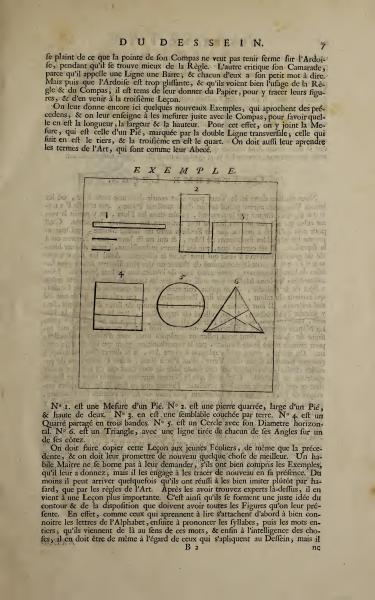On Drawing
There is a complaint that the point of the compass does not remain firm on the slate, while it seems better suited to a ruler. Another critiques his friend for calling a line a bar; and each has his own little remark. But since the slate is too slippery, and they see the use of the ruler and compass, it is time to give them paper, to draw their figures, and to proceed to the third lesson.
Here they are given some new examples, similar to the previous ones, and are taught to measure them precisely with the compass, to know their length, width, and height. For this purpose, the measurement of a 'foot' is included, marked by double transverse lines, the next section is a third, and the third section is a quarter. They are also taught the terms of art, which are like their ABCs.
Example
No 1. is a measurement of a foot. No 2. is a square stone, a foot wide and two high. No 3. is a similar one lying on the ground. No 4. is a square divided into three bands. No 5. is a circle with its horizontal diameter. No 6. is a triangle, with a line drawn from each of its angles on one of its sides.
Students should copy this lesson as well as the previous one, and they should be promised something better each time. A skilled teacher does not merely ask if they have understood the examples given; he encourages them to trace them again in his presence. At least, it can happen sometimes that they have succeeded more by chance than by the rules of art. After finding them proficient, he proceeds to more important lessons. Thus, they form a correct idea of the outline and arrangement that all the figures presented to them must have. In fact, just as those learning to read first strive to properly know the letters of the alphabet, then to pronounce syllables, and then entire words; from there they reach the meaning of these words, and finally the understanding of things; it should be the same for those who apply themselves to drawing; but he cannot
Translation Notes
1. 'Pié' could be translated as 'foot', a unit of measurement.
2. 'Ardoise' means slate, a writing material used in the past.
3. 'Compas' means compass, used for drawing circles and precise measurements.
